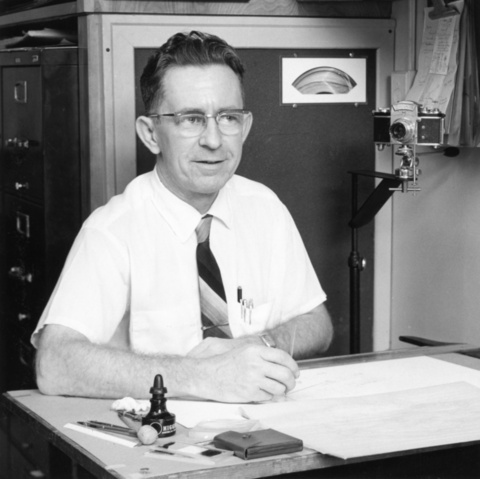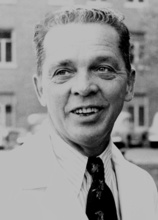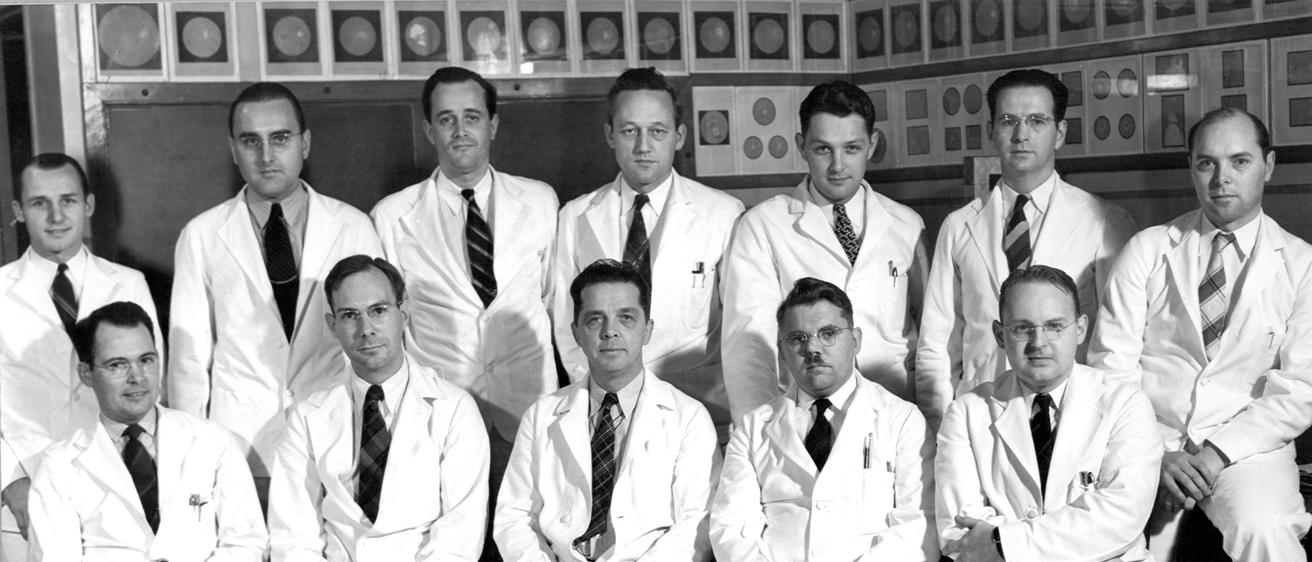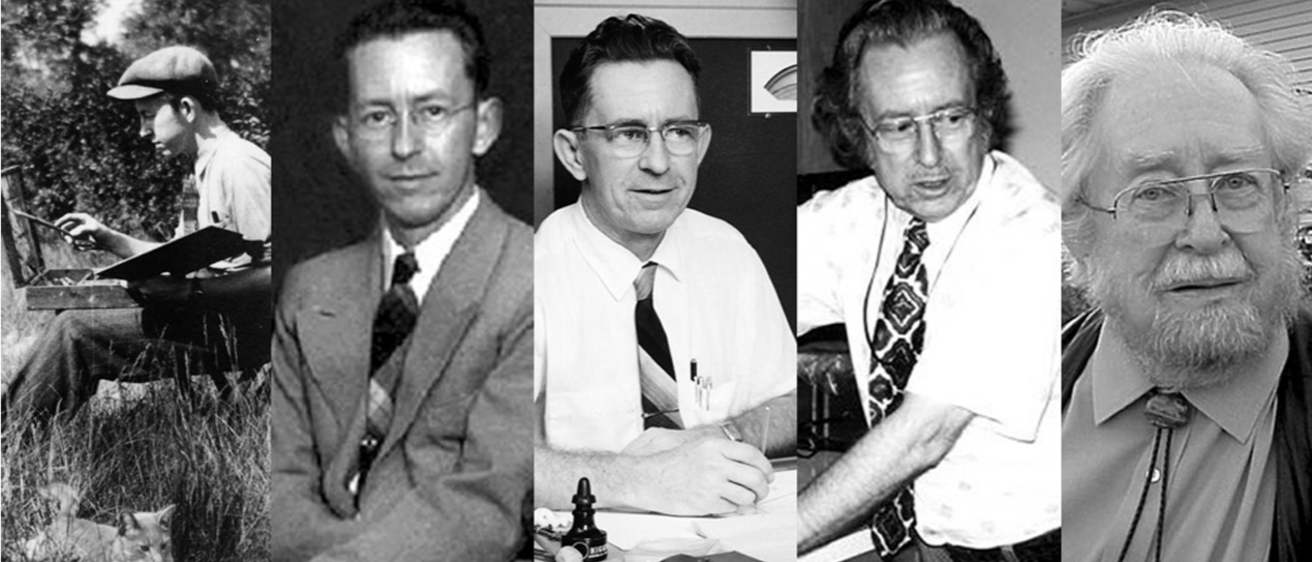Main navigation
Table of Contents
A Department Grows and Attracts Talented Faculty
The University of Iowa's Department of Ophthalmology saw remarkable advancements from 1935 to 1944, largely due to the visionary leadership of Dr. Cecil Starling O'Brien. Appointed in 1925, Dr. O'Brien's tenure was marked by significant strides in both clinical practice and research. By 1937, his efforts were recognized nationally when he was elected as a director of the American Board of Ophthalmology. This period was crucial in establishing the department's reputation for excellence in ophthalmic education and patient care.

One of the key developments during this time was the recruitment of talented individuals who would contribute to the department's growth. In 1937, Lee Allen was hired to draw the fundus of the eye, and under Dr. O'Brien's mentorship, he developed innovative photographic and gonioscopic techniques that were widely published.

Additionally, Dr. O'Brien brought in Peter Salit, a biochemist with a keen interest in cataract formation, and Phillips Thygeson, who specialized in the microbiology of the eye. These hires significantly bolstered the department's research capabilities and clinical expertise.
The physical infrastructure of the department also saw notable improvements. Initially housed on the second floor of the new general hospital built in 1928, the department quickly outgrew its space. By 1946, plans for expansion were underway, and by 1949, the department moved into a newly remodeled and expanded area. This new space included a modern clinic area with advanced equipment, which greatly enhanced the department's ability to provide high-quality patient care and training.
Dr. O'Brien was also instrumental in shaping the educational framework of the department. He established a rigorous training program for residents, emphasizing both basic and clinical sciences of ophthalmology. Morning rounds, a tradition he started, became a cornerstone of the department's educational program and continue to be an integral part of the training process1. This structured approach ensured that residents received comprehensive education and hands-on experience, laying a strong foundation for their future careers.
By the end of this era, the University of Iowa's Department of Ophthalmology had firmly established itself as a leader in the field. The advancements made during these years not only enhanced the department's reputation but also contributed significantly to the broader field of ophthalmology. Dr. O'Brien's leadership and vision were pivotal in transforming the department into a center of excellence that continues to thrive today.
Major Events in the Department between 1935 and 1944
1937 - Lee Allen hired as ophthalmic artist by Dr. O'Brien

In 1937 Lee Allen was hired to draw the fundus of the eye and with encouragement from Dr. O'Brien, Allen developed a number of photographic and gonioscopic techniques and published them in the ophthalmic literature.
Allen used a tubular electric binocular ophthalmoscope, of the kind that were later developed into fundu~ cameras. It provided some degree of stereopsis. It was table mounted and had a chin rest for the patient. It was possible for the patient to lean back and stretch while Lee painted, and then come back to the same position so that Lee could take another look without putting down his brush. Lee Allen was fascinated by stereopsis; it became his hobby.
1937 - O'Brien was elected by the American Board of Ophthalmology to be a director

This was clear recognition that he had built a distinguished department in the corn fields of Iowa and that he was a national leader in the training of ophthalmologists. He served on the board until 1950.
For five years he was the Secretary and Treasurer of the Association for Research in Ophthalmology, and he served on the Executive Committee of the Ophthalmological Study Council, and on various committees of the Pan-American Association of Ophthalmology. He was recognized as one of the outstanding teachers of Ophthalmolgy of his era.
1938 - The sudden and tragic death of Mrs. Mary O'Brien
Mary Grey O'Brien (1900-1938) was the daughter of Mr and Mrs J. E. Grey of Towanda, PA. She had a younger sister, Frances (1909-1938) and younger brothers, John and Robert. Mary Grey was a beautiful young woman who married O'Brien in 1923 and they had a daughter, Patricia, in 1924. Mary O'Brien went back to college at the University of Iowa, majored in Art and received her BA in 1937. She was very interested in the design of homes and in 1938 the O'Briens were completing the construction of a group of “duplex homes" on Woolf avenue south of the bridge, near where the VA hospital now stands, according to plans and designs laid out by Mary O'Brien.
Mary O'Brien’s younger sister Frances also graduated from the University of Iowa, where she met and in 1925 married "Roxy" Ball (1902-1938). In 1936 they moved to Newton, Iowa, where Mr Ball became the advertising manager of the Newton Daily News. In September 1938 Mary O'Brien planned to spend a few days with her sister, Francis, in Newton; she wanted to make a trip to Des Moines to pick out furniture for her new apartments.
On Thursday September 15th Mrs O’Brien, her sister Francis, and Francis’ husband, Mr Ball, had all been in Des Moines and were returning to Newton after dark with Mr and Mrs Thomas H. Gould in the back seat when they crashed into a westbound truck. Mr Ball was driving and they were coming around a flat curve on Highway 6 near Colfax (nine miles west of Newton) when they side-swiped the left side of the on-coming truck. The collision pulled the car under the bed of the truck tearing off the entire top of the car. Mr and Mrs Ball and Mrs O'Brien were in the front seat and were killed instantly. Mr and Mrs Thomas H. Gould were seriously injured but survived.
Word reached O'Brien that evening. John Grey, Mary O'Brien's brother was one of O'Brien's residents; they arranged to drive to Newton first thing in the morning. Velva Stitt (O'Brien's surgical nurse) was in a restaurant in Iowa City that evening and heard the news on the radio. She assumed that O’Brien’s surgery the next morning would be cancelled, but later that evening got a call from the nursing supervisor asking her to report as usual for surgery. It seems the patient had come a long way and had no intention of having her surgery postponed—so O'Brien agreed to do it as planned. Miss Stitt said later that O’Brien was tight-lipped but steady handed during the procedure, and seemed to be forcing himself through the surgery. When it was done, he turned without a word, walked out and stayed away from work for three days. That morning O'Brien and his brother-in-law John Grey drove to Newton to arrange for the burials.
Lee Allen: The Artist Who Revolutionized Ophthalmic Illustration
Lee Allen, born Edwin Lee Allen in 1910 in Muscatine, Iowa, was a multifaceted artist whose contributions spanned from regionalist painting to groundbreaking work in medical illustration. His journey as an artist began under the tutelage of notable figures like Grant Wood and Diego Rivera, but it was his tenure at the University of Iowa's Department of Ophthalmology that truly set him apart in the medical community.
Early Artistic Pursuits
Allen's early years were marked by a deep engagement with the arts. After graduating from East High School in Des Moines in 1928, he studied at the Cumming School of Art and later at the University of Iowa. His artistic journey took a significant turn when he worked with Grant Wood on various public art projects, including murals funded by the Works Progress Administration (WPA). This period honed his skills in mural painting and introduced him to the fresco medium, which he studied further under Diego Rivera in Mexico in 1935.
Transition to Medical Illustration
In 1937, Allen accepted a position as a medical illustrator at the University of Iowa's College of Medicine, Department of Ophthalmology. This role would define his career for the next 39 years. His work involved creating detailed illustrations of the eye's anatomy and various ophthalmic conditions, which were crucial for medical education and research.
Innovations in Ophthalmic Techniques
Allen's contributions to ophthalmology were not limited to illustration. He was instrumental in developing several photographic and gonioscopic techniques that enhanced the field's diagnostic capabilities. His meticulous illustrations and photographs were published in numerous ophthalmic journals, making complex concepts more accessible to both students and practitioners.
Influence on Modern Ophthalmology
Allen's influence on modern ophthalmology is profound and multifaceted. Here are some key areas where his contributions have had a lasting impact:
Advancements in Ophthalmic Photography
Allen developed innovative techniques and equipment for ophthalmic photography, including a specialized camera for photographing the fundus of the eye. This allowed for more precise and detailed documentation of retinal conditions, significantly improving diagnostic capabilities. His work laid the foundation for modern retinal imaging techniques used today.
Gonioscopy Techniques
Allen's contributions to gonioscopy, the examination of the front part of the eye, were groundbreaking. He developed methods that enhanced the ability to diagnose and treat glaucoma, a major cause of blindness. His detailed illustrations and photographs made complex anatomical structures more understandable for both students and practitioners.
Educational Impact
Allen's meticulous illustrations were used extensively in medical education. His ability to translate complex ophthalmic concepts into clear, detailed images helped train generations of ophthalmologists. His work is still referenced in ophthalmic textbooks and journals, underscoring its enduring educational value.
Founding of the Ophthalmic Photographers' Society
In 1969, Allen co-founded the Ophthalmic Photographers' Society and served as its first president. This organization has played a crucial role in advancing the field of ophthalmic photography, promoting professional development, and setting standards for practice.
Prosthetic Eye Development
After retiring in 1976, Allen co-founded Iowa Eye Prosthetics, Inc., where he applied his artistic skills to create realistic and functional prosthetic eyes. This work has improved the quality of life for many patients, demonstrating the practical applications of his artistic and technical expertise.
Personal Documentation of Macular Degeneration
In his later years, Allen documented his own experience with macular degeneration through drawings and writings. This unique perspective provided valuable insights into the condition and helped raise awareness about its impact on vision. His book, "The Hole in My Vision: An Artist’s View of His Own Macular Degeneration," published in 2000, offers a detailed account of his journey with the condition.
Legacy and Later Years
Allen's impact on the field of ophthalmology extended beyond his technical innovations. He was a founding member and the first president of the Ophthalmic Photographers' Society in 1969, reflecting his commitment to advancing the profession. After retiring in 1976, he continued to contribute to the field by co-founding Iowa Eye Prosthetics, Inc., where he applied his expertise in creating prosthetic eyes.
In his later years, Allen faced a personal battle with macular degeneration, a condition that gradually impaired his vision. True to his artistic spirit, he documented this journey through a series of drawings and annotations, which culminated in his book, "The Hole in My Vision: An Artist’s View of His Own Macular Degeneration." This work provided a unique perspective on the condition, blending personal experience with medical insight.
Lee Allen's career at the University of Iowa's Department of Ophthalmology was marked by a blend of artistic talent and scientific innovation. His illustrations and inventions have left a lasting legacy in the field of ophthalmology, demonstrating the profound impact that art and science can have when they intersect. Allen's story is a testament to the power of creativity and dedication in advancing medical knowledge and improving patient care.

